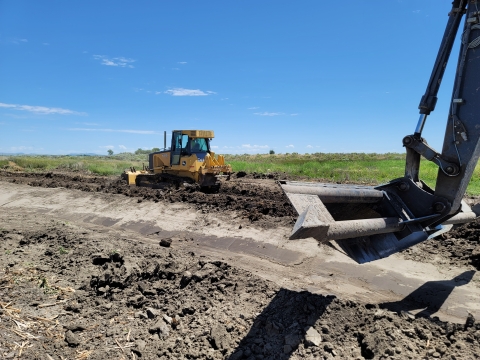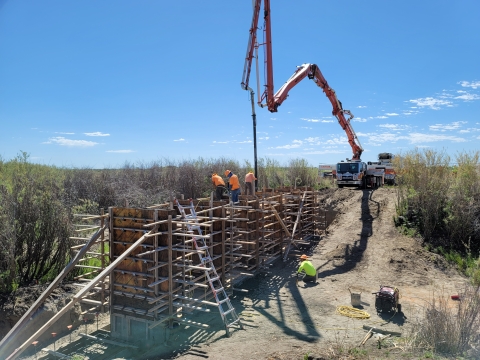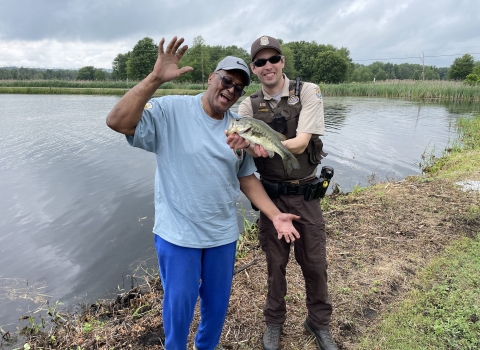Camas National Wildlife Refuge is usually a quiet place to immerse yourself in nature.
Tucked away in eastern Idaho, the 11,000-acre refuge is located in a rural farming area. In addition to a multitude of wildlife, visitors find picturesque 270-degree views of the Teton, Centennial, Beaverhead, Lemhi and Lost River mountain ranges.
Beginning this summer, however, the chirping of birds will be replaced with the growl of heavy machinery.
The refuge has kicked off a $7.8 million project with Great American Outdoors Act Great American Outdoors Act
This landmark conservation law, enacted in 2020, authorizes the use of up to $1.9 billion a year in energy development revenues for five years for needed maintenance to facilities and infrastructure in our wildlife refuges, national parks, forests, recreation areas and American Indian schools.
Learn more about Great American Outdoors Act funding. The project will rehabilitate the water delivery systems of Camas NWR, improve wildlife habitat, enhance public access to better support visitors, and improve roadways to support birdwatchers, photographers and hunters.
“This will be an incredible improvement for Camas National Wildlife Refuge – for both our wildlife and our visitors,” said refuge manager Brian Wehausen. “The combination of climate change climate change
Climate change includes both global warming driven by human-induced emissions of greenhouse gases and the resulting large-scale shifts in weather patterns. Though there have been previous periods of climatic change, since the mid-20th century humans have had an unprecedented impact on Earth's climate system and caused change on a global scale.
Learn more about climate change , reduced snowpack and changes in local agricultural practices since the 1980s have altered the hydrology of the area, making it difficult to manage water effectively. This project will make us a good neighbor through improved water use.”
The Great American Outdoor Act is part of the administration’s America the Beautiful initiative, which is a decade-long campaign to conserve, connect and restore 30% of our lands and waters by 2030. The effort aims to support locally led and voluntary conservation work across public, private, and Tribal lands and waters. This initiative will also create jobs and strengthen the economy’s foundation, tackle the climate and nature crises, and address inequitable access to the outdoors.
The majority of the Camas NWR project is expected to be completed by fall 2022.
The water delivery systems of Camas NWR were originally built from the 1940s to 1960s when Camas Creek typically ran every year and water flowed freely from artesian wells. Today, the refuge relies heavily on deep ground water wells to augment limited water received from Camas Creek.
This project will:
Relocate wells closer to the most productive wetlands.
Replace and rehabilitate three miles of open water delivery ditches.
Add an additional Camas Creek diversion structure structure
Something temporarily or permanently constructed, built, or placed; and constructed of natural or manufactured parts including, but not limited to, a building, shed, cabin, porch, bridge, walkway, stair steps, sign, landing, platform, dock, rack, fence, telecommunication device, antennae, fish cleaning table, satellite dish/mount, or well head.
Learn more about structure , which will improve wetlands within the waterfowl hunting area; and improve riparian riparian
Definition of riparian habitat or riparian areas.
Learn more about riparian habitat.
“We’ll be using geo tech liners to line the porous delivery ditches on the refuge,” Wehausen said. “We will be able to accumulate more water in our priority wetland basins by eliminating the water loss in our delivery ditches, which will be a boon to waterfowl and other waterbirds.”
The refuge’s improvements will have a positive impact on people, too. Improvements include:
Resurfacing approximately 6 miles of auto-tour route with gravel.
Asphalting a section of bird trail to make it more ADA friendly.
Updating and replacing all refuge interpretive signs, which will include content provided by the Shoshone-Bannock Tribes.
The refuge is also looking to the future with its infrastructure projects. The boardwalk will be made with a recycled material, which has a 50-year life expectancy and will significantly reduce the refuge’s cost to maintain. The refuge is also installing solar panels to offset power costs by providing green energy into the system. The three 100 kilowatt solar panel arrays, a first for a Service facility in Idaho, will offset about 80% of the electrical costs associated with providing water to the new habitat.
Camas NWR was established in 1937 to manage habitat to benefit nesting waterfowl. Birdwatching, photography, and hunting of waterfowl and elk are some of the primary uses of the refuge.






